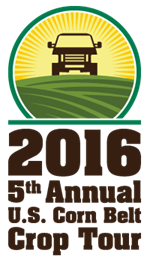Eighth state in a 12-state tour
By Andrea Gal
Managing Editor, Integrated Media
Farms.com
The Farms.com Risk Management team visited North Dakota on day nine of the fifth annual U.S. Corn Belt Crop Tour.

Moe Agostino, Farms.com Risk Management chief commodity strategist, highlighted “90 per cent of North Dakota’s land is occupied by farms.”
The tour stopped to look at some canola fields as they approached Rugby, North Dakota. Agostino said “about 60% of the crop is blooming,” which places the crop’s progress “ahead of last year.”
A challenge for a number of farmers this year, according to Agostino, is weed pressure - “particularly in beans, not so much in the corn.” Farmers have identified the weed marestail (also known as horseweed), in particular, as troublesome.
Mark Rohrich of Ashley, North Dakota discussed another issue that seems common this year – a lack of recent rainfall. There has been a “30 to 40 per cent chance (of rain) for days,” said Rohrich, but the rain has “passed us more than a few times.” He stressed “rains in July and early August, especially, will make or break our corn and soybeans.”
In terms of staging, the corn was about knee high, which is typical for North Dakota this time of year.
As with South Dakota, Agostino ranked the North Dakota crop as average, with a score of 6 or 6.5 out of 10.
Be sure to check back daily as more videos from the tour are posted. The next stop on the tour is Minnesota.
Use the hashtag #cornbelt16 to follow the tour on social media.